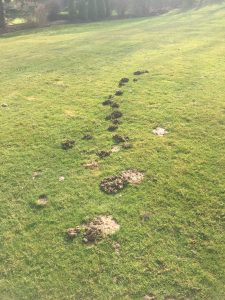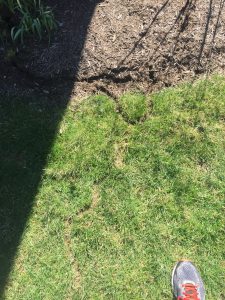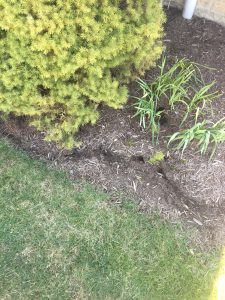Mole or Vole…What’s the Difference?
You are looking at your lawn or mulch bed and it is disturbed.
That, in turn, makes you disturbed because you know some creature has been crawling around making this damage but you’re not sure which animal.
In today’s post we’ll differentiate between mole damage and vole damage; informing you how to distinguish between the two.
Why does it matter? Because knowing what animal is causing the damage informs the actions you should take to manage the problem. You’re not going to solve mole problems with vole removal methodology and vice versa.
More Than A Beginning Letter
Whoever gave these small mammals their English names didn’t do a lot of pre-planning. The one letter difference in what they’re called often proves to be a stumbling block in communication about the animals. The whole mole/vole thing always causes confusion.
So, before we go any further, let’s clear it up.
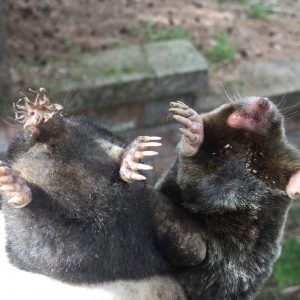 A mole is an insect eating, underground dwelling, dirt digging machine.
A mole is an insect eating, underground dwelling, dirt digging machine.
They have large front hands and claws for digging.
In Ohio we have three types, two of which are pictured.
The mole on the left with the funky nose is a Star-nosed mole.
The one on the right is either an Eastern mole or a Hairy Tailed Mole. Without seeing the tail it’s hard to tell the difference. We do catch more hairy tails here in the Akron, Canton, Kent area, but it could be either.
Other distinguishing traits are 1) small eyes (they’re not blind!) most likely unseen because they are obscured by fur and 2) no external ears.
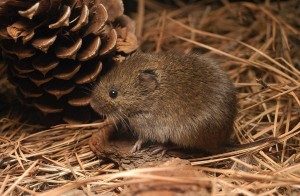 Voles are much different. They are plant eating, surface active, mouse-looking animals.
Voles are much different. They are plant eating, surface active, mouse-looking animals.
Accordingly, voles are also known as field mice.
And if were up to us, the term vole would go away and the different types would be given names that had mouse somewhere in them.
Their eyes are very visible and their external ears are also pretty easy to see. They have thin tails.
Mole Damage Versus Vole (Field Mouse) Damage
Moving on to damage, to the left is a picture of classic mole damage called mounding; little piles of dirt everywhere.
This is the dirt excavated from the tunnel that is under the surface connecting all those mounds.
Evidence of a lot of moved dirt makes sense considering those claws pictured above are so well adapted for it.
To the right we see classic vole (field mouse trails.
Notice there are no large excavations.
Because they don’t move much dirt, there will be no mounding associated with voles (field mice). They may burrow holes to make a nest sub-surface, but they don’t make a mess. The damage they do is from eating the plant material that is in their pathways and eating the roots of some ornamental shrubs they live in.
Here is a good example of some holes that lead to burrows. There are a couple of small holes on the outer trail and there is a larger one in the center of the emerging grasses.
In mulch, voles make paths by pushing the mulch out of the way. This makes concave little passageways open to the surface. You can think of vole travel paths as ruts.
Mole tunnels, however, may raise the surface when they are not deep but are still entirely covered.
When mole tunnels are close to the surface the tops of the tunnel are convex and may be pushed down as you walk. As the vole pathway can be thought of as a rut, the mole pathways can be thought of as tunnels.
So, when considering whether the paths you are seeing in your yard and mulch beds are the result of moles or voles (field mice), our advice is to ask yourself these two questions
- “Do those pathways seem more like surface ruts or true tunnels”?
- “Is there a lot of excavation(mounding) and raised areas or does it just seem like things have been pushed out of the way?”
Your answers to these questions and comparing what you see to these and other pictures your research finds will help you determine if moles or voles are the main problem.
Different Methods of Trapping Moles and Voles
Determining what sort of animal is doing the damage is a key to finding a solution.
That’s because moles and voles are removed with different traps and trapping styles.
Since moles thrive under the surface, that’s where the trapping needs to happen. Anyone who tells you different, and believe us when we say we’ve heard from many, is not going to be a consistent mole trapper.
Vole (field mice) run their surface ruts. Thus, trapping is accomplished on these runs usually close to burrows.
Mole and Vole Trapping | Akron, Canton Kent, Ohio
To find out more how we can help you with a mole or vole problem please give us a call.
Also, please look through other parts of our website for more information.
